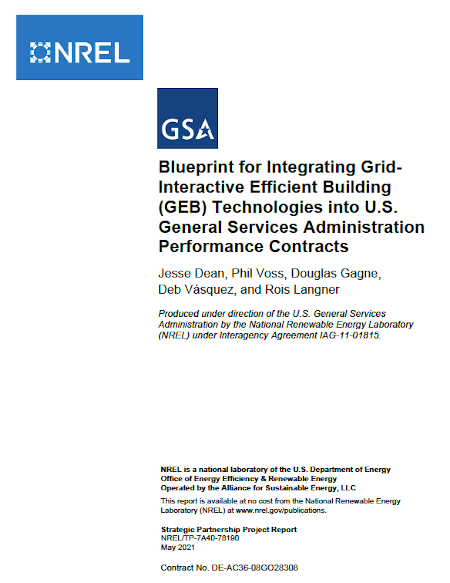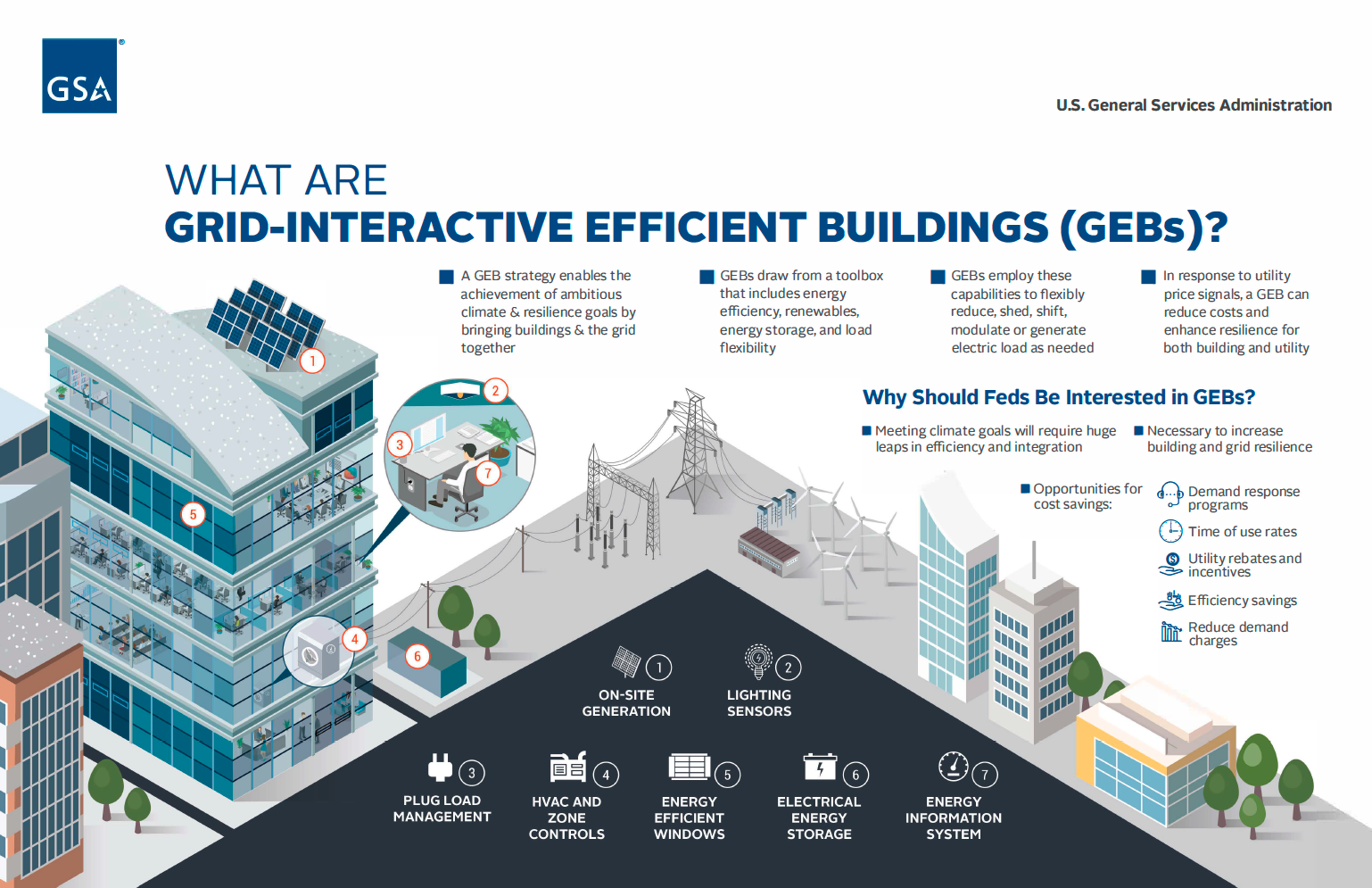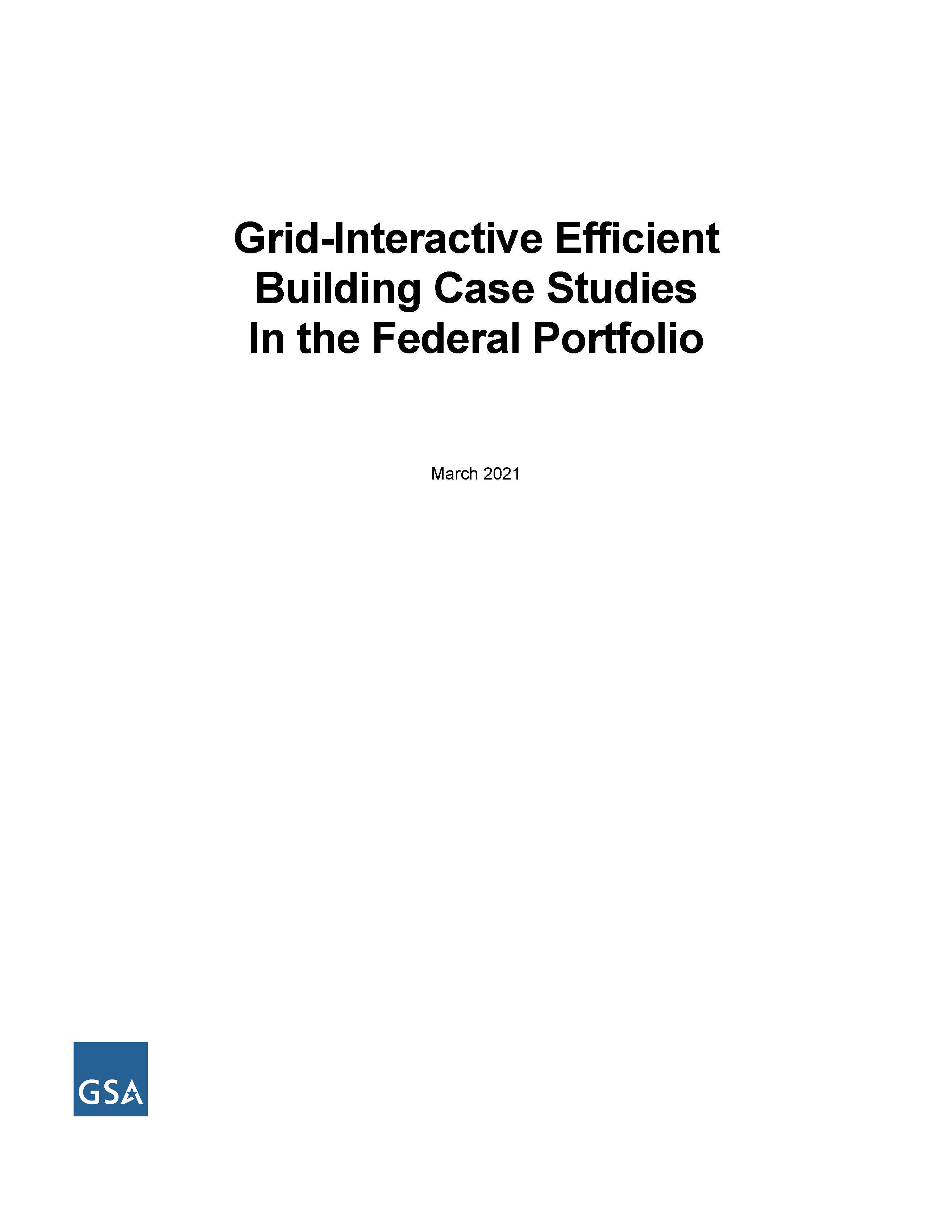Grid-Interactive Efficient Buildings
GEB Blueprint
What is a Grid-Interactive Efficient Building (GEB)?
GEB = Energy Efficiency + Demand Flexibility
The U.S. electric power sector is changing in both challenging and exciting ways. Among the factors influencing this evolution are:
- The growth of renewable energy sources, and the decentralization of power generation into more distributed energy resources;
- Technological improvements in energy storage, communications, sensors and controls;
- Clean energy and climate goals driving efficiency improvements as well as renewables adoption
- Increasing need for resilience, from climate change, terrorism, etc.;
- Changes in electric rate structures opening the door– and increasing the imperative – to find new ways for building owners and operators to save money.
All of these factors are driving interest in building and grid integration, a set of strategies, practices and technologies to dynamically shape energy loads, help agencies meet their missions, provide resilience and valuable services to the power grid while saving money for building owners and operators and the taxpayer.
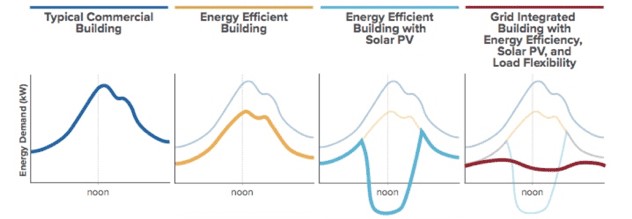
The U.S. Department of Energy’s Building Technologies Office created the concept of Grid-Interactive Efficient Buildings (GEBs)![]() , uniting the goals of building energy efficiency and building and grid integration into one suite of strategies.
, uniting the goals of building energy efficiency and building and grid integration into one suite of strategies.
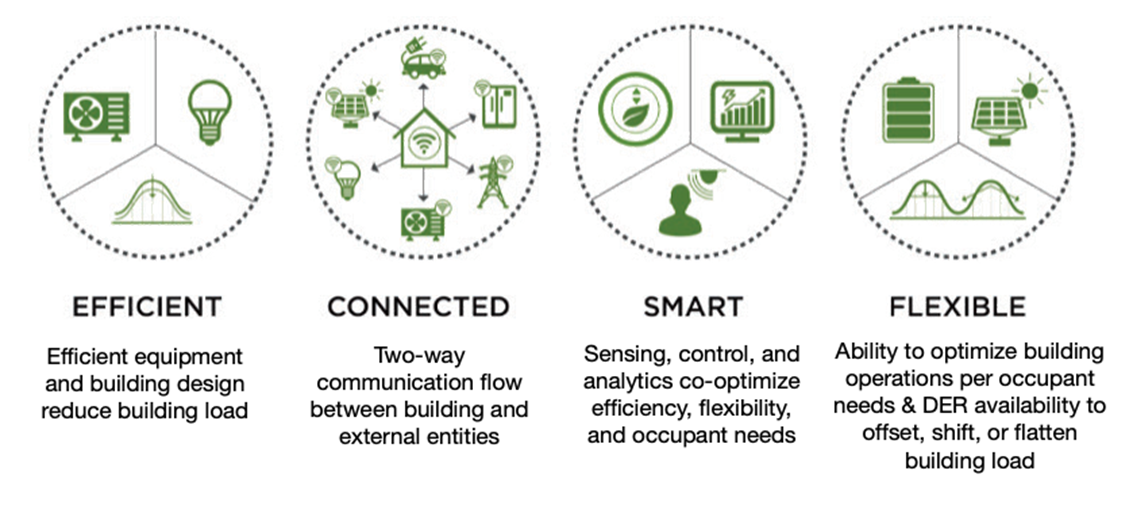
Adapted from: Department of Energy EERE GEB Overview
GEBs:
- Enable achievement of ambitious climate & resilience goals by bringing buildings & the grid together;
- Draw from a toolbox that includes energy efficiency, renewables, energy storage and load flexibility;
- Employ these capabilities to flexibly reduce, shed, shift, modulate or generate electric load as needed;
- Respond to utility price signals to reduce costs and enhance resilience for both building and utility.
Table 1. The Value of GEBs
| Attribute | Today | Future |
|---|---|---|
| 1. Interoperability and intelligence from building to grid |
|
|
| 2. Interoperability and intelligence across building systems |
|
|
| 3. Load flexibility and demand-focused optimization |
|
|
What is GSA doing on GEBs?
Two members of GSA’s Office of Federal High-Performance Buildings summarized initial progress on GEBs with a presentation![]() at a meeting of the Interagency Sustainability Working Group in December 2019.
at a meeting of the Interagency Sustainability Working Group in December 2019.
Benefits and Challenges to GEB in Federal Buildings
GEB Case Studies
Barriers to overcome, per the Advisory Committee:
- Provide Information & Resources: Case studies, design guidance, modeling tools
- Establish GEB Policies: Create load reduction goals
- Improve Price Incentives & Financing Models:
- ID where Utility, Regional Transmission Organization (RTO), and/or Independent System Operator (ISO) rates & incentives make GEB options attractive
- Integrate into ESPC/UESC frameworks
- Overcome Operational Knowledge Gaps & Security Concerns:
- Need smart controls, advanced metering, cybersecurity protections
- Revise operator procedures & training
- $50 MM in annual cost savings
- $206 MM in net present value (NPV)
- Project-level payback under 4 years
- Futureproof: Accommodates future rate structure changes and helps manage costs
- Reduce grid-level transmission and distribution (T&D) and generation costs up to $70 MM/yr
- These savings ultimately benefit the government and taxpayers
- Future grid economic models will value savings (e.g., non-wires alternatives)
- Demonstrates federal and real estate industry leadership
- Enables deeper savings in Energy Savings Performance Contracts (ESPCs) and Utility Energy Service Contracts (UESCs)
- Better building control can improve comfort, health, and productivity
- CO2 savings
Additional Information
- Advice Letter and Report: Recommendations for Adoption of Grid-Integrated Building Policy Provisions
 - Initial findings and recommendations on why the federal government should launch building and grid integration policies and practices.
- Initial findings and recommendations on why the federal government should launch building and grid integration policies and practices. - Advice Letter: Federal Building & Grid Integration: Proposed Roadmap
 – More detailed and targeted recommendations for how the federal government should make this transition.
– More detailed and targeted recommendations for how the federal government should make this transition. - GSA responded by funding the Rocky Mountain Institute in 2019 to produce a feasibility study of GEB implementation at six GSA locations, Value Potential for Grid-Interactive Efficient Buildings in the GSA Portfolio: A Cost-Benefit Analysis
 .
. - The U.S. Department of Energy's Building Technologies Office
 provides a growing collection of technical reports and other resources on GEBs.
provides a growing collection of technical reports and other resources on GEBs. - Grid Optimal
 : a partnership between the New Buildings Institute and U.S. Green Building Council to provide standards, tools, and guidance to improve building-grid interactions in the built environment by empowering owners, architects, and engineers with dedicated metrics, strategies, and pilot projects.
: a partnership between the New Buildings Institute and U.S. Green Building Council to provide standards, tools, and guidance to improve building-grid interactions in the built environment by empowering owners, architects, and engineers with dedicated metrics, strategies, and pilot projects. - Grid-Interactive Efficient Building Utility Programs: State of the Market: An ACEEE White Paper
 : (October 2019) - Research by the American Council for an Energy-Efficient Economy (ACEEE).
: (October 2019) - Research by the American Council for an Energy-Efficient Economy (ACEEE). - National Association of State Energy Officials (NASEO)
 : Website includes several studies and resources for state agencies to investigate and initiate GEB programs.
: Website includes several studies and resources for state agencies to investigate and initiate GEB programs. - Smart Buildings Case Study at GSA's Oklahoma City Federal Building
 : This GEB renovation project demonstrates that GEB-ready strategies and technologies can be deployed across buildings with minimal investment and includes information on the project roles, processes, costs, and benefits.
: This GEB renovation project demonstrates that GEB-ready strategies and technologies can be deployed across buildings with minimal investment and includes information on the project roles, processes, costs, and benefits.
Related Topics
Energy Efficiency
Energy efficiency is a comparison of the amount of energy used compared to the amount of output produced. In the built environment, this means using the least amount of energy (electricity, natural gas, etc.) to operate a facility appropriately. Steps that can help a building run efficiently include: ensuring there are no air leaks, using sensors or timers to ensure the building isn’t operating when vacant, and using energy-efficient equipment.
Renewable Energy
Renewable energy comes from sources that are either inexhaustible or can be replaced very rapidly through natural processes. Examples include the sun, wind, geothermal energy, small (river-turbine) hydropower, and other hydrokinetic energy (waves and tides). Using renewable energy reduces a building's carbon footprint. There are various options for providing renewable energy to buildings, the most common being solar photovoltaic (PV) panels. Buildings can also purchase renewable energy from offsite sources.
DOE | Office of Energy Efficiency and Renewable Energy![]()
Resilience
The ability to anticipate, prepare for, and adapt to changing conditions and withstand, respond to, and recover rapidly from disruptions.

